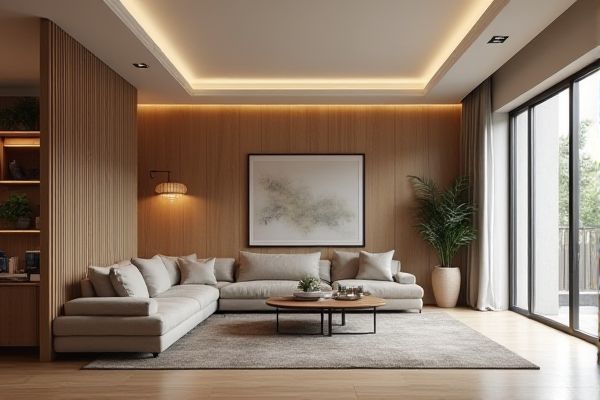
Fixed vertical dividers offer a stable, sturdy partition ideal for defining clear, unchangeable spaces, while movable dividers provide flexibility, allowing you to easily reconfigure areas to suit changing needs or preferences. Discover which option best fits your space and lifestyle by reading the full article.
Table of Comparison
| Feature | Fixed Vertical Dividers | Movable Vertical Dividers |
|---|---|---|
| Definition | Stationary vertical lines separating content sections. | Adjustable vertical lines users can drag to resize sections. |
| Use Cases | Static layouts with fixed content width. | Dynamic layouts requiring flexible content sizing. |
| User Interaction | No user interaction; purely visual. | Interactive; users can drag to customize section widths. |
| Implementation Complexity | Simple; often implemented via CSS. | Complex; requires JavaScript for drag functionality. |
| Performance Impact | Minimal; no scripts needed. | Moderate; event listeners may affect performance. |
| Accessibility | Generally accessible with proper markup. | Requires additional ARIA roles and keyboard support. |
| Customization | Limited to fixed sizes and styles. | Highly customizable by the end user. |
| Responsiveness | Static; may not adapt well on various screen sizes. | Adaptive; allows manual adjustment on different devices. |
| Examples | Newspapers, static dashboards. | Split views in code editors, resizable panels. |
Introduction to Vertical Dividers
Vertical dividers serve as essential elements in design and architecture to create structured spaces or visually separate components on a page or screen. Fixed vertical dividers provide consistent, unchanging boundaries that enhance clarity and organization, while movable dividers offer flexibility, allowing dynamic adjustment to optimize space based on your needs. Choosing between fixed and movable vertical dividers depends on whether your priority is permanence and stability or adaptability and customization.
Defining Fixed Vertical Dividers
Fixed vertical dividers are permanent elements installed within layouts, providing consistent separation between sections without the option to adjust their position. These dividers are commonly used in web design and print layouts to maintain structure and enhance readability by clearly demarcating content areas. Unlike movable dividers, fixed vertical dividers ensure stability and uniformity, preventing layout shifts and preserving the intended visual hierarchy.
Exploring Movable Vertical Dividers
Movable vertical dividers offer unparalleled flexibility for reorganizing your space, adapting easily to changing needs without requiring permanent installation. Unlike fixed vertical dividers, they allow for customizable partitioning, enhancing room functionality and maximizing usable area. With adjustable positioning, movable vertical dividers optimize space management while maintaining an open, dynamic environment.
Material Choices for Vertical Dividers
Fixed vertical dividers commonly utilize durable materials such as metal, wood, or glass, providing structural stability and long-term resistance to wear. Movable dividers often incorporate lightweight materials like aluminum frames with fabric or acrylic panels, allowing easy repositioning and customization. Selecting materials depends on factors including required durability, aesthetic preference, and flexibility needs for space management.
Space Optimization: Fixed vs Movable Dividers
Fixed vertical dividers provide consistent and reliable space segmentation, ensuring designated areas remain unchanged for optimal organization. Movable dividers offer flexible space optimization by allowing adjustments based on varying needs, maximizing usability in dynamic environments. Selecting between fixed and movable dividers depends on the requirement for permanence versus adaptability in space management.
Installation Process and Complexity
Fixed vertical dividers typically require a straightforward installation process involving permanent mounting, which ensures stability and long-term durability but limits flexibility. Movable dividers offer a more complex installation due to mechanisms like sliding tracks or hinges, allowing you to easily adjust or relocate them as needed. Understanding the trade-off between installation complexity and adaptability helps tailor divider choices to your specific spatial and functional needs.
Flexibility and Adaptability in Interior Design
Fixed vertical dividers provide stable, permanent separation that defines distinct spaces, ideal for structured layouts requiring consistent boundaries. Movable dividers enhance flexibility and adaptability by allowing you to easily reconfigure room layouts to suit changing needs, making them perfect for dynamic environments. Choosing between fixed and movable dividers depends on how much versatility your interior design demands for efficient space utilization.
Cost Comparison: Fixed and Movable Dividers
Fixed vertical dividers generally have a lower initial cost due to simpler materials and installation processes, making them ideal for budget-conscious projects. Movable dividers incur higher expenses because of their complex mechanisms, materials for flexibility, and maintenance needs over time. Long-term investment in movable dividers can be justified by their adaptability, reducing the need for future construction costs when altering spaces.
Maintenance and Durability Factors
Fixed vertical dividers offer superior durability due to their stable construction, requiring minimal maintenance over time. Movable dividers involve more mechanical components that may wear out or loosen, increasing the need for regular inspection and maintenance. You should consider fixed dividers if long-term reliability and low upkeep are priorities in your space.
Choosing the Right Vertical Divider for Your Space
Fixed vertical dividers provide stable, permanent separation ideal for defining distinct areas in offices or homes, enhancing privacy and structure. Movable dividers offer flexibility, allowing easy reconfiguration to adapt to changing space needs in dynamic environments. Selecting the right vertical divider depends on space usage, desired mobility, and aesthetic preferences to optimize functionality and design.
 homyna.com
homyna.com